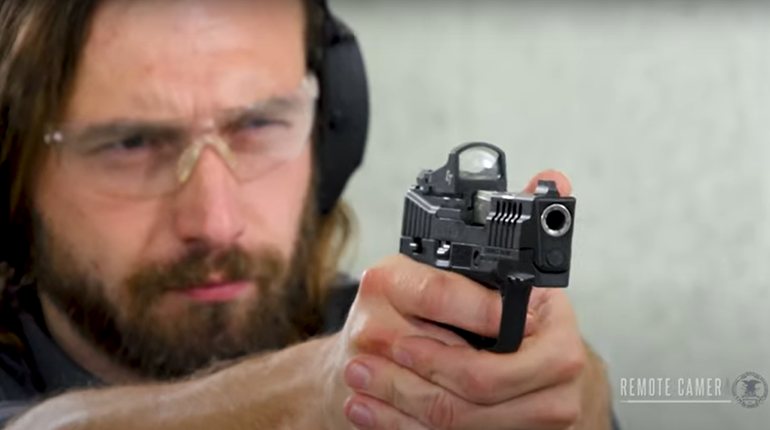
It’s been an interesting decade or so. Gasoline engines are out, electric cars are in. Big bores are out, “mouse guns” are in. It’s now OK to venture forth carrying a handgun in something less than .40 caliber. You don’t lose all your friends simply because you didn’t physically stop them from leaving the house carrying an easily concealed, small-caliber pistol.
Granted, the .380 ACP has been around for decades, although it was never really a fashionable round in America. Two events changed that. First, the ammunition manufacturers put some serious development and marketing efforts into bullets for the small round. Second, the two biggest domestic handgun manufacturers (Smith & Wesson and Ruger) introduced tiny, lightweight pocket pistols chambered in .380 ACP. Or maybe it was the other way around. Regardless, the result was a boom in the .380 ACP market. Americans who believed in the more subtle (as in concealed carry) art of self-defense began reaching for their wallets. Now, as Ruger’s best-selling LCP pistol nears its 10th anniversary, the company is offering an upgrade in the form of its new LCP II.
The Ruger LCP platform is a recoil-operated, locked-breech, semi-automatic pistol with an internal hammer. Going with the locked breech rather than the more-common blowback design allows the use of less mass in the slide and lighter recoil springs. With an overall length of just more than 5 inches and an empty weight of only 10.6 ounces, it is the very definition of a modern pocket pistol. Carrying six rounds in the magazine and one in the chamber, it has a 40-percent increase in capacity compared with America’s previous standard pocket pistol, the five-shot, small-frame revolver. That’s important because one magazine is all that’s furnished with the new gun.

A major design change is the LCP II’s new trigger. Like many other semi-automatic pistols on the market, it has a safety integrated into the trigger, or if you prefer, a “trigger in the trigger.” While I’m not a big fan of that feature per se, I am in favor of lighter and crisper trigger pulls on fighting handguns, especially compared with that found on the original LCP. Ruger has definitely achieved a good trigger in the LCP II. There is virtually no resistance in the 1⁄8 inch of travel it takes to press the safety flush into the face of the trigger, and almost no resistance in the next 3⁄8 inch or so of taking up the slack in the main trigger. The last 1⁄4 inch of trigger travel requires about 5 to 6 pounds of pressure to release the hammer. I rate crispness of pull as more important than weight of pull (within reason), and there was no mushiness in the LCP II’s trigger—when the trigger hit the final resistance, there was no farther movement until the hammer fell. What was even more impressive was the trigger’s short travel distance to reset. Basically, it reset after it returned the last quarter-inch of movement. Ruger calls it a “Single-Action Only” (SAO) trigger, because the internal hammer is cocked by the cycling slide, not by the initial pressure on the trigger as in a striker-fired handgun.
Another major change is that the LCP II’s slide locks back after the last round in the magazine is fired. To me, this feature becomes more important when the pistol is particularly small, simply because the gun has less real estate to grab when you’re trying to operate the controls. Magazines from the new LCP II will work in the older LCP, but will not lock the slide rearward. Seven-round magazines from the old LCP will not operate in the newer pistol, but the six-round variants will, though they won’t hold the slide open on empty on the LCP II, either.
The frame on the LCP II, while still made of nylon-reinforced glass fiber to keep the overall weight as light as possible, went through some changes that affect both ergonomics and shooting characteristics. The trigger guard has been changed to a more rectangular shape to allow easier access for the trigger finger. More importantly to me, there is a trigger stop molded into the base of the trigger guard, which prevents the trigger from traveling any farther than necessary when the gun is fired and ensures a quick reset with the absolute minimum of return travel.
The backstrap portion of the frame is wider on the LCP II and felt better than the thinner grip frames found on many other .380 ACP pocket guns. It doesn’t really help manage recoil, but rather ergonomically improves the grip, which helps the little gun’s natural pointing characteristics. When firing two-handed, the pistol tended to line up with the target when raised to eye level.
Surface texture of the LCP II’s grip is rougher than on the older model—more like skateboard tape than the molded checkering style of finish on the original version. On the frontstrap and backstrap, there are strips with an even more aggressive finish than on the sides. For me, these changes helped in controlling the little gun, particularly as the rate-of-fire increased.
The LCP II’s slide has also undergone some changes. Serrations have been added to the front of the slide, with both front and rear serrations being angled. Combined with a softer recoil spring design, manual operation of the slide has become easier. There is a cut in the rear of the slide that allows you to see the internal hammer (the top part of the hammer, at least) if the gun is cocked. No visible hammer means the gun is not cocked. There is also a slot, which Ruger calls a “view port,” cut in the slide on the edge of the ejection port that lets you see if there is a cartridge in the chamber. On an outdoor range in bright sunlight, both features worked well. In low-light conditions, or even just indoors without relatively bright lights, good luck to anyone over 45 years old. Those with older eyes will have to work on their manual loading procedures and learn to perform a reliable tactile chamber check of the little gun, which is actually a useful skill for any shooter.
Similar comments regarding light conditions are in order for the new sights on the LCP II. The front-sight blade and rear sight notch are both tall and wide for a .380 ACP pocket pistol, with the idea of increasing visibility and thus facilitating precise shot placement. Accuracy tests were run on an outdoor range between the hours of 11 a.m. and 3 p.m. under a bright sun that accounted for the 94-degree temperature. For these tests, I used bullseye-style targets with light grey centers and a white background.

The LCP II’s sights were great, meaning they were quite visible and presented an excellent sight picture. But when I switched to Dirty Bird’s small, silhouette-style targets with a black background, things deteriorated. Even using my DeCot shooting glasses with the prescription insert for the dominant eye, I could not get a decent sight picture. Worse, it was difficult to merely find the front sight against a dark-colored target.
One other problem surfaced during my 15-yard accuracy tests: All of the loads I tested grouped between 3 to 4 inches low and left of the aiming point. Part of that is on me—I tend to pull shots low and left when firing Lilliputian-size pistols, particularly when shooting integral-safety trigger systems. That said, I was pleased with the group sizes, and even with the low-left offset, all shots would have been chest-cavity hits in a real-life encounter. The LCP II’s sights are integral to the gun’s slide with no means of adjustment for either windage or elevation. I wouldn’t be worried about changing elevation; for fast, close encounters you’re mainly indexing on your front sight, and it’s a bit above the rear sight notch. Something as simple as a touch of white paint on the front sight blade would go a long way to solving the low-light-visibility problem. But I can’t walk away from that windage variation. Maybe having a gunsmith remove some metal from the inside of the rear sight would help, but I have yet to attempt that fix.
Let’s talk about actually shooting the LCP II. I performed absolutely no preliminary cleaning of the pistol before heading for the range. The first 25 rounds were to get velocity readings. The next 125 rounds were for accuracy testing, all of which were shot with me seated and my arms resting across my range bag. Rounding up about another 50 to 100 rounds of assorted, leftover .380 ACP ammo, I went to work on downsized silhouette targets starting at 10 yards and working in to 3 yards. Different brands of ammo (and bullet types) were randomly loaded into the one Ruger magazine. As you would expect, the closer I got to the target, the faster I shot.
As the day wore on, the LCP II got hotter and dirtier. The action, particularly the trigger pull, began to feel gritty. I did not stop to clean it. During the entire day, there was exactly one malfunction somewhere near the 200-round mark (a failure to feed) when I was rapidly emptying magazines into the small silhouette targets. I went through the prescribed clearing drill learned at Gunsite (slightly modified to adjust for the pistol’s tiny size) and finished off the magazine, including the offending round, which stayed in the mag when I cleared the malfunction. During all of the rapid-fire strings, there was only one miss, but keep in mind that the Williams-style rapid fire is considerably slower than what most other folks do. To close out the day, I launched a few rounds at the full-size silhouettes located 50 yards downrange. By holding on the point of the target’s left shoulder, I rang steel about half the time.

Overall, I’m impressed with the Ruger’s improvements to the LCP platform. Unfortunately, I hadn’t taken the Ruger box to the range, so I didn’t get a chance to switch magazine bases (Ruger provides two with the gun.) I tested the gun using the magazine with the extended finger tab, and it does provide some extra real estate for gripping purposes. That said, I did some subsequent dry firing with the flat base installed, and the gun did seem to point more naturally, especially when shooting one-handed. The flat plate also makes the gun even smaller, a desirable feature in a CCW pocket pistol. Given the minimal recoil of the .380 ACP cartridge, switching to the flat mag plate might be worth a try. By the end of my day at the range, the 200-round shooting session had raised a blister on the bottom of my trigger finger. However, it’s doubtful that the average purchaser is going to expend that much ammo during a single trip to the practice range with this diminutive pistol.
Ruger’s inclusion of a good pocket holster with the gun is an excellent idea. No pistol should be carried in a pocket without a holster, and to paraphrase Doc Holliday, “The LCP II is a daisy of a pocket pistol.”






































